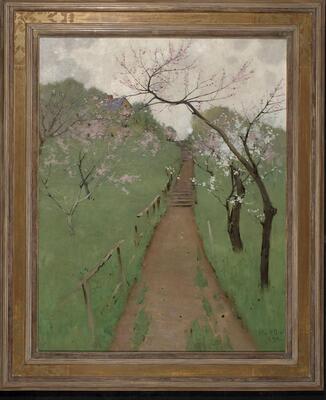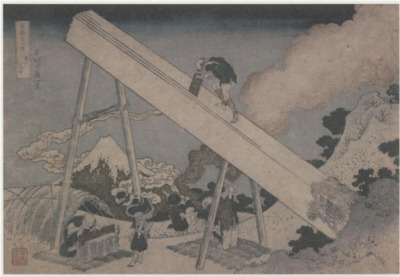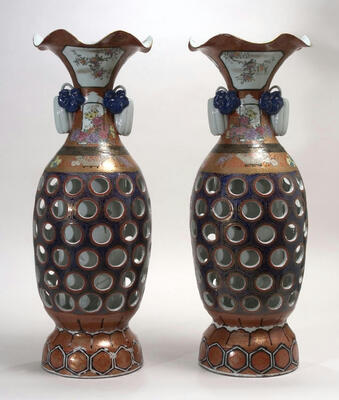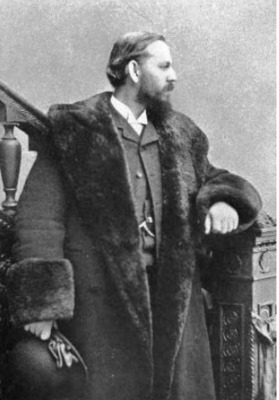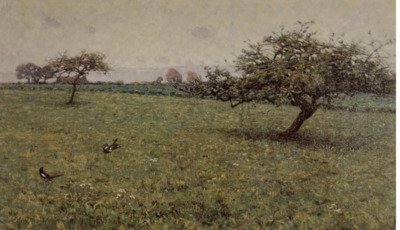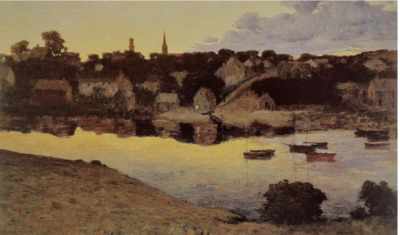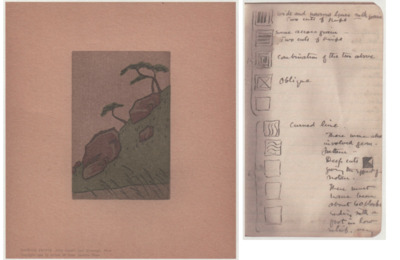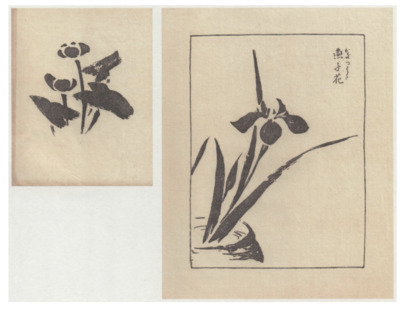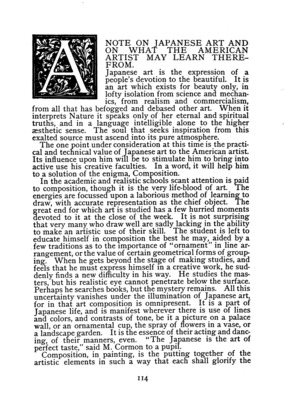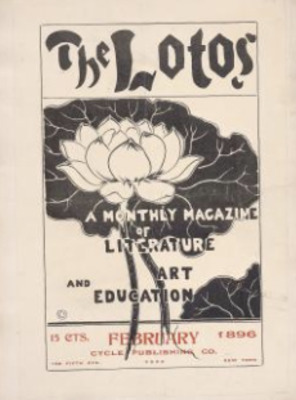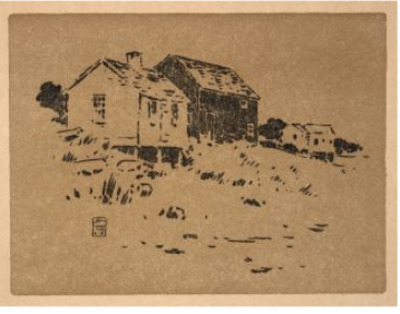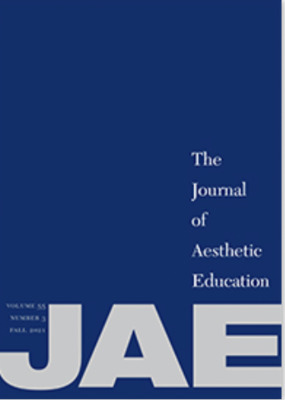Analysis of Spring Landscape by Arthur Wesley Dow
Slate Davis, Erica Pillar, Emily Strauss, and Mingxuan Yang collaborated on this research report about Arthur Wesley Dow and the influences of his 1892 Spring Landscape painting for their Art and Life in Nineteenth-Century America class at the University of Michigan in Winter 2022.
Introducing Arthur Wesley Dow’s Spring Landscape, the Beginning of his Synthesis of Western and Eastern Art:
Arthur Wesley Dow was an American artist, teacher, and writer from the late 1800s through the first half of 1900. Through his synthesis of Western and Eastern art, he brought a tremendous influence on American art and design. Inspired by Japanese art which utilized the simplistic line and coordinated with the lines, notan, and color to achieve harmony, Dow implemented this open-minded approach at the Ipswich Summer School of Art as early as 1892 and published the book Composition in 1899. Rather than obeying the formula or imitating nature, Dow advocated for creating and designing art by embodying nature’s pure feeling and glorious aesthetic sense. The piece Spring Landscape was created in 1892.
Dow simplifies a calm hillside in his 1892 painting, Spring Landscape. Below a cloudy sky, the painting depicts a long, tilted dirt path leading towards a yellow and blue house on a hill. Mostly hidden by brush and trees, the house is by no means the focal point of Dow’s work. Instead, the eyes of the reader are initially drawn to the path that runs through the center of the canvas. As the viewer follows the path up the canvas, the pink cherry blossom tree on the right hand side of the canvas begins to droop into the forefront, becoming the focal point of the painting's upper half. The incorporation of cherry blossom trees paired with the use of bright, yet saturated colors, and brushstrokes that shine under light, suggests that Spring Landscape is intended to communicate an overall atmosphere of joy.
Dow, enlightened by Hokkei’s Ukiyo-e, tried a new vantage point of landscape painting by applying Japanese aesthetic principles. This artwork is very important in indicating how Dow incorporated aesthetic understandings of landscape painting from Western and Eastern cultures.
Arthur Wesley Dow Biography:
Arthur Wesley Dow was born in 1857 in Ipswich, Massachusetts, a place where he returned to establish the Ipswich Summer School of Art around 1900. In the fall of 1884, Dow went to Paris and entered the Académie Julian accepting professional education in art. Dow went back to Boston and brought many European ideas back to the United States in 1889. Dissatisfied by the aggressive inheritance of European traditions of art in America, Dow was seeking new styles for American arts and developing new theories of artistic expression by looking up artwork in various cultures. As one of the central leaders of the American Arts and Crafts Movement, Dow identified composition as the universal of art after he appreciated Katsushika Hokusai’s woodcuts ukiyo-e in the Museum of Fine Arts in Boston in 1891. In Ipswich Summer School of Art, Dow taught students new art principles by applying three elements: notan, color, and lines into artwork to achieve harmony. With the help of Ernest Fenollosa, Curator of Far Eastern Art at the museum, Dow confirmed his interest in Japanese art and devoted himself to the reform of the American art style. In Dow’s art principle, nature was just a reference point, but real art needed a higher sensitivity to aesthetics with creativity and mental force to design art, devoid of formula and imitation. He envisioned art as power and emphasized abstract quality. Dow’s impact on aesthetic understandings and teaching approaches was so considerable that it shaped and spread into U.S. art education, art history, and training for artists from the late 1800s through the first half of 1900.
Cultural Forces that led to the Groundwork for a Taste for Japonisme in the United States by the 1890s:
As the Industrial Revolution spread throughout the United States in the 19th century and the American economy became increasingly dependent on large-scale industry, the factory system, and mechanized manufacturing, the U.S government wanted to open new markets overseas to sell manufactured goods and buy raw materials. In 1853, Commodore Matthew Perry commanded vessels of the Navy into Tokyo and demanded Japan to open their ports to the U.S. merchant ships. The Treaty of Kanagawa was officially signed in 1854, which allowed trade at two ports in Japan.
After trade opened up, the desire for Japanese art and culture began in the West. Simultaneously, the advent of Japonisme in American art mainly complimented the growth of the Arts and Crafts movement in the 1890s and early 1900s, with its emphasis on the honesty of basic, natural materials and quality of craftsmanship in all types of things. At the center of Western fascination with Japanese art were Ukiyoe, wood-block prints. Ukiyo-e woodcuts blended expert craftsmanship in block design and cutting with a straightforward aesthetic focused on line and space placement. Pictured to the left is an example of a popular wood-block print by Katsushika Hokusai circa 1831.
American artists, architects, scholars, and intellectuals traveled to Japan to study their culture. Japanese woodblock prints, screens, fans, textiles, large scale vases, detailed bronzes, and fragile lacquerware were appreciated by American collectors and galleries. In fact, in 1872, the term Japonisme was created by Phillip Burty, a French critic, to encapsulate the influence of Japanese art and design. American audiences were first introduced to Japanese art in the Centennial Exposition of 1876, where the Japanese Pavilion was a notable exhibit that demonstrated textiles, ceramics, and aesthetic refinement. This pictured pair of porcelain vases on the right, made by Nanri Kajū between 1868 and 1875, were on display at the Centennial Exposition, and they were considered to be remarkable according to official reports of the display. Japanese art attracted American artists and the attention of American people because it was a new, subjective approach and a rejection of realism, embodying characteristics of early Modernism. Similarly, the Japanese values of hand-craftsmanship and beautiful design brought American audiences a sense of escape and relief in the chaos and pollution of modern industrial life. Japanese art went hand in hand with the “art for art’s sake” philosophy because Japanese graphics displayed artistry and expressivity.
→ Influential Artists: James Abbott McNeill Whistler and Ernest Fenollosa
After this point, American Japonisme gained traction. American artist James Abbott Whistler is assumed to have started creating Japanese pictures in the Spring of 1864. He was inspired by the pictorial strategies of Japanese art to make pictures off-centered and more focused on the aesthetic and composition by using the Japanese technique of two-dimensional design and large, ambiguous foregrounds within his artwork. After Dow discovered these inspiring Japanese techniques of composition at the Boston Library in 1891, he wrote to his wife Minnie in a letter, “It is now plain to me that Whistler and Pennell, whom I have admired as great originals, are only copying the Japanese.” It is clear that American Japonisme impacted and inspired many artists like Dow and Whistler during this time period, and Dow was aware of Whistler’s inclusion of these techniques too. Dow’s 1892 painting Spring Landscape reveals the beginning of his inclusion of Japanese principles, which were discoveries that would change the entire trajectory of his artistic technique that would only grow in the coming years.
In regard to Dow's thought on the synthesis of eastern and western art, the story and ideas of Ernest Fenollosa should not be overlooked. Ernest Fenollosa was born in 1853 in Salem, Massachusetts, and was invited to teach philosophy and political economy at Tokyo Imperial University in 1878. Fenollosa began his research on Japanese visual culture and collected pottery, paintings, and woodblock prints in Japan. Aiming to change contemporary Japanese art through an educational program that emphasized abstract design principles and rejected present imitative practices of western academic art, Fenollosa later founded the Tokyo Academy of Fine arts, in which instruction centered around the bare elements of line, notan, and color, fulfilling a harmonious space-filling. He was the only "non-Oriental" in Tokyo at the time who could assess the current Western phenomenon from a Japanese perspective. In 1890, He returned to Boston being employed as the curator of the Japanese department at the Museum of Fine arts where he met Arthur Wesley Dow. Dow complimented Fenollosa in his book Composition: “He was gifted with a brilliant mind of great analytical power, this with a rare appreciation gave him an insight into the nature of fine art such as few ever attain," (Dow, 1913). Fenollosa argued that drawing from observation and plaster casts, which were common practices in American art education at the time, were detrimental to artistic training, and that line, notan, and color ruled both the decorative and pictorial arts. As a result of his initial contact, partnership, and lifetime collegial relationship with Fenollosa, this idea became the core of Dow's teaching, talks, and publication. Fenollosa's knowledge as a historian, philosopher, and scholar, as well as Dow's skill as a respected art instructor, studio art teacher, and artist, were the strengths of Fenollosa and Dow's combined talents. Fenollosa's role in rekindling American enthusiasm in collecting Japanese and Asian art was crucial, but his theories had an incalculable impact through Dow's lectures, teaching, and textbooks.
Dow’s Art Before Spring Landscape:
Because of Dow’s discovery of Japanese printmakers and art in 1891, many of his paintings completed before Spring Landscape contain many stylistic differences. Arthur Wesley Dow’s artistic journey began around 1878, at the age of 21. Similar to his later works, including Spring Landscape, Dow began sketching landscapes and scenes of rivers and houses in his hometown of Ipswich, Massachusetts. Within two years, by 1880, Dow was selling his paintings and entering pieces in various exhibitions. With saved up money, Dow decided to depart for Paris in 1884 and further develop his style of painting at Académie Julian. Unfortunately, the details of Dow’s life while he was abroad are not fully known because of the “unfortunate loss of the bulk of [his] letters and manuscripts” (Moffatt 2). However, what is known about the time Dow spent in Paris is how his paintings evolved and how his style at the time compared to his style post Spring Landscape.
One way to understand how Dow’s art changed over time is to compare some of his early paintings with Spring Landscape and his overall artistic style after he was influenced by Japanese printmakers. For example, in June of 1881, a couple years before he decided to depart for Paris, Dow was treated to a vacation to Concord, New Hampshire. It was in concord that he completed his painting Landscape.
When comparing the two pieces, the similarities lie within the pronounced brushstrokes and calm, peaceful setting. However, when looking at the color palette, subject matter, and composition, the two seem to differ. Before the discovery and influence of Japanese art, Dow’s color palette was darker. This resulted in some of his earlier paintings, including Landscape, to not communicate such a joyous feeling as Spring Landscape. The reason for the use of a darker palette is because Dow’s paintings at the time were more focused on realistic details of the landscape and less about the composition of the painting.
The fact that Dow’s early paintings did not focus on their composition directly relates to Dow’s discovery of Japanese prints. Due to Japanese influence, paintings as early as Spring Landscape show “a radical transformation from his earlier style in which he was solely reliant on nature to one that uses nature as a resource but not as an end in and of itself ” (Arthur Wesley Dow: His Art and His Influence 110). Many of these same similarities and differences in Dow’s paintings over time can be seen in all of the paintings to the right. Ipswich at Dusk contains a darker color palette compared to his paintings after Spring Landscape. A Field, Kerlaouen is more reliant on the reality of nature rather than the overall composition of the painting that Dow develops later in his career. This painting also uses a much darker color palette compared to his paintings after Spring Landscape.
Dow’s Epiphany or Satori (in Zen Buddhist terms) that impacted Spring Landscape and the rest of his art:
Dow became enthralled by the Japanese technique of composition and decorative effect when he read a book of Hokusai and Hiroshige woodcut illustrations in February of 1891 because he valued the three components of composition: line, notan, and color. In a letter to his wife he wrote, “One evening with Hokusai gave me more light on composition and decorative effect than years of study of pictures. I surely ought to compose in an entirely different manner and paint better” (Green 20). Dow was also inspired by the ukiyo-style wood-block prints by Hokkei, one of Hokusai’s students who demonstrated how simple modifications on a single concise line could convey trees, wide hills, buildings, and grass.This epiphany, or Satori, is revealed in The Spring Landscape that was created in 1892. It shows a clear shift in artistic approach: he began implementing new ideas of line notan, and color as early as 1892 in his landscape work. It is also notable that Dow considers Japanese composition to be superior, as he was motivated to “paint better” after being exposed to it.
Line: in Spring Landscape: Dow started creating sumi (Japanese black ink painting) in 1891, which emphasized simple brush drawings. More specifically, lines in Japanese art were free and not limited to only straight lines. According to Dow, lines were used to divide the surface of the painting. At the same time, Dow was exploring how to create flat, linear representations of nature. Dow experimented with a new perspective for drawing the landscape by dividing the earth and sky unevenly, with more land than sky. Furthermore, higher horizons confined the sky to a tighter region, which is uncommon in terms of actual relationships and distances. Dow recognized the value of ambiguity between the represented picture and the literal surface while working in the Japanese art style.These techniques are notable in Spring Landscape because the curved lines of the path and the long cherry blossom branch divided the surface of the painting to create a flat snapshot of the landscape, even though it is of an upward climbing hill. The simple brush strokes relate to the simple, free form ink strokes of Sumi.
Notan: Dow explained the impact of Notan in the Boston Publication The Knight Errant, A Note on Japanese Art and on What the American Artist May Learn There From. Notan was the dark and light principle and as Dow described, “In every good Japanese work there is a clearly defined Notan idea. It is seen in its simplest form in designs, and even in the most elementary geometrical pattern the artist balances his dark and light delicately and tenderly. Notan is not light and shadow, but an eternal principle of art, and the Japanese compose in it with matchless daring united to an unerring sense of the beautiful.” The Spring Landscape demonstrates the balance of dark and light in the contrasting dark, defined colors of the trees on the right compared to the faded, lighter trees on the left. Additionally the light nature of the overhead clouds contrasts the greenery. Additionally, the light on the grass appears to be darkest in the bottom left corner, and the grass becomes lighter as the path increases and the eyes follow the hill higher up the painting.
Color: Japanese wood cut art included color saturation and blocks of different colors. In The Spring Landscape, there is a brighter palette, particularly with the pink details on the blossoming tree. Before, Dow created darker, French paintings with less colors. This switch to use more “radical colors” shows how Dow began to reject realism because realism was simply an imitation of art. The book, Arthur Wesley Dow His Art and His Influence, explained it well, “For him, the most important aspect of Japanese art was its use of nature as a reference point, not as an end in itself, a total refutation of his academic training (Green 20).”
The Spring Landscape marks the beginning of Dow’s transformation, so it continued to evolve to encompass more prominent features of Japanese technique in his own artwork, and in the artwork of his students. Dow's sketchbook, ink paintings, colored woodcuts, and oils displayed his fascination and liking for eastern art and design in the 1880s and 1890s.
Spring Landscape through the lens of Dow's 1899 Book Composition:
Dow had a bit of an interesting perspective when it came to landscape painting. When it came to it, he took a less traditional approach– instead of painting exactly what he saw, he wanted to make his paintings more individualistic. Additionally, he, as well, appreciated more than the technicalities of lines and shapes in the painting. In Dow’s own words: “the whole fabric of art education should be based upon a training in appreciation. This power cannot the imparted like information. Artistic skill cannot be given by dictation or acquired by reading. It does not come by merely learning to draw, by imitating nature, or by any process of storing the mind with facts. The power is within—the question is how to reach it and use it” (Composition). He wanted the viewer to look beyond what is right in front of them, and instead be able to appreciate the usage of the principles he delves deeper into in his book, Composition, and how they work together to make a landscape painting carry an air of harmony.
Dow’s Composition (1899) is widely regarded as the first design text of the American Arts and Crafts Movement. Until Composition, art education was more centered around copying the “masters”. Dow had a program in place for educating teachers of all levels the “visual grammar: a pattern language toolbox that could be used to make every aesthetic decision: right down to the decoration of their studios or the parlors in their homes. Composition’s presentation of visual art as an analytic and constructive — rather than imitative — activity was the first tangible breath of abstraction to reach the American classroom” (Public Domain Review). Composition acted as an insight to creating pieces that as a whole held an air of harmony, as lines, colors, and patterns came together cohesively.
In Composition, Dow proposes five principles that allow audiences to begin and better understand art appreciation through landscape painting. They are as follows:
Opposition
Transition
Subordination
Repetition
Symmetry
Looking at his principles of composition, Dow utilizes each principle in different ways. If we look at opposition, in which he writes that “two lines meeting form a simple and severe harmony”, we can look at the dirt path that draws the eyes of the audience the most, and notice that the lines that outline the path appear to meet where the path ends. However, opposition can tend to be a bit harsh when there’s just two lines connecting at a point.
This is when transition comes in to soften up the piece and bring more harmony to the painting as a whole. If we look at the fence along the left side of the path, Dow brought this third line in to add “an effect of unity and completeness”.
The third principle, subordination, is most evident with the Japanese cherry blossom trees that line the dirt path of the landscape. Dow writes that “To form a complete group the parts are attached or related to a single dominating element which determines the character of the whole. A tree trunk with its branches is a good type of this kind of harmony; unity secured through the relation of principal and subordinate, even down to the veinings of leaves—a multitude of parts organized into a simple whole.” So, we can see that he makes use of this principle particularly with the tree closest to the foreground of the piece, which appears to be the most ornate and detailed tree. When looking at it in depth, there are different variations of line lengths, positionings, and hues, but viewed in conjunction with the rest of the painting brings a sense of harmony.
Dow presents repetition as a contrast to subordination. Instead of complex lines and figures that as a whole produce a sense of unity, there’s a familiarity and comfort within repeated shapes or figures in a piece. We can see repetition in the vertical posts of the fence, as well as the repetition of the color pink in the trees– which somewhat overlap with pieces of subordination as well.
His last principle is symmetry, which doesn’t seem to have an huge presence in this piece. He utilizes the first four in order to create the mood that he wanted to evoke. This is important to note, because he emphasizes that these principles are “by no means recipes for art, and their names are of little consequence. Appreciation of fineness of relations must always govern the method and form of composition. It is possible to use all the principles here discussed, and to complete all the exercises, without gaining much, if any, art experience. The main thing is the striving for the best, the most harmonious, result that can be obtained”
In simple terms, he is saying that anyone can use these principles exactly as they’re written and produce a pretty nice piece. However, it’s about the appreciation of how these principles work together to create the harmony that he is striving for. As discussed above, these principles are by no means a cheat sheet to making beautiful art. Dow is using them to teach artists how to incorporate these elements into their work to make a cohesive, and harmonious work.
Dow’s Art After Spring Landscape:
Spring Landscape was released in 1892, and shortly after, he released his book ‘Compositions’. Looking at his pieces from before Spring Landscape and beyond, we are able to see how he took different approaches to landscape painting and diverted to other forms of art as well, such as woodblock printing.
He went on to embody more of the elements of Japonisme in his later work, in which we can see elements such as asymmetry, and strong diagonal lines that give them more of a sense of dynamism. We see more elongation in his lines and the perspectives are more flattened, compared to the depth we see with his earlier pieces. His later works like Modern Art (1895), The Lotos (1896), Ipswich Prints: Ink Sketch (1914), and Ipswich Marshes (1914)lacked the depth that was found in his work before his Spring Landscape painting. He sought less to copy Japanese art and more to synthesize and bring a more western approach to it. He applied his appreciation of Japanese art to Western landscapes. This is important to note as he did let Japonisme influence much of his work, but did not simply copy his style from other artists– using his principles he was able to make it his own.
The Public’s Reaction to Arthur Wesley Dow: Well Known and Respected at Home and Abroad
Arthur Wesley Dow was not only highly respected after he passed away, but he was also respected in the art community throughout his entire career. Popular in not only America but Japan as well, Dow was invited to speak at several public meetings and conferences to share his thoughts on different artistic styles and the art community. Partially because of Dow’s desire to begin teaching art in 1891, his artistic ideas and styles were well known. For example, between 1899 and 1901 Emil Lorch was the assistant director of the Art Institute of Chicago and had “invited [Dow] to address the 1901 Architectural League of America convention” (Nute 277). This invitation from Lorch was a significant acknowledgement of Dow's contribution to his field.
Additionally, during his time in Japan, on December 14th 1903, Dow spoke before the Chamber of Commerce of Kyoto. This was significant because it was a gathering of all the businessmen, educators, and people of the city simply interested in art. During his hour long talk Dow told the audience of his “interest in their art and what it meant and should mean to the Western world. He took this opportunity to state very frankly his opinions relative to the error he felt many Japanese artists were making in giving up their own tradition and accepting without question those of Europe” (Okazaki 86). This opinion makes sense in regards to Dow’s own style of painting. When he discovered Japanese prints he did not completely change his style of painting; he allowed it to influence his style and build upon what he had already become good at. Just as he did not give up his own style because of Eastern influence, he did not want to see the Japanese people give up their traditions just because of Western popularities.
What is also important to note about his address is that the man who arranged the meeting introduced Professor Dow to the Japanese audience as a “great contributor to the development of American art” (Okazaki 86). This further reinforces the fact that Dow was well respected as an artist and educator in both America and Japan throughout most of his career.
Bibliography:
Art, Philadelphia Museum of. “West Meets East: China and Japan at the Centennial Exhibition.” Philadelphia Museum of Art. Accessed April 18, 2022.https://www.philamuseum.org/exhibitions/2002/188.html
Arthur Wesley Dow, Ipswich Marshes, 1914, color woodcut, Smithsonian American Art Museum, Gift of Charles J. Robertson III, 2015.68
Arthur Wesley Dow, Ipswich Prints: Ink sketch, 1902, photo-mechanical relief reproduction on paper, Smithsonian American Art Museum, Gift of Mrs. F. F. Reinert, 1976.96.3.5
Arthur Wesley Dow, Modern Art, 1895, color lithograph on paper, Smithsonian American Art Museum, Gift of Gary and Brenda and Harrison Ruttenberg, 1997.31
Arthur Wesley Dow, The Lotos, 1896, color lithograph on paper mounted on paperboard, Smithsonian American Art Museum, Transfer by exchange with Georgetown University, 1981.111.4
Boyle, Richard J. "Arthur Wesley Dow in Japan." Archives of American Art Journal 52, no. 1/2 (2013): 58-69.
Chiba, Yoko. "Japonisme: East-West renaissance in the late 19th century." Mosaic: A journal for the interdisciplinary study of literature (1998): 1-20.
“Commodore Perry and Japan (1853-1854): Asia for Educators: Columbia University.” Commodore Perry and Japan (1853-1854) | Asia for Educators | Columbia University. Accessed April 18, 2022. http://afe.easia.columbia.edu/special/japan_1750_perry.htm.
“Created Using Microsoft Sway.” Microsoft Sway. Accessed April 19, 2022. https://sway.office.com/pRgv7ZUuAyseHf59?ref=Link.
Dow, Arthur W. "A Note on Japanese Art and on What the American Artist May Learn There-From." The Knight Errant 1, no. 4 (1893): 114-117. This note is an essential primary source including Dow’s insightful analysis on the characteristics of Japanese art and how American artists can learn from it. He pointed out the importance of pure feeling, creativity, and sensitivity to aesthetics and regarded it as the core of art and criticize realism and commercialism.
Dow, Arthur W. Composition; a Series of Exercises in Art Structure for the Use of Students and Teachers. 9th ed., Doubleday, Page & Co., 1914. This book outlines the principles that Arthur Wesley Dow used in his paintings, and the first edition was published in 1899, while he was a professor of fine arts at Columbia University in New York City, NY. It is meant to serve as a reference for appreciating and creating art with the intention of achieving complete harmony in an artwork. This book is based on what he learned throughout his twenty years of teaching and painting.
Green, Nancy E., and Jessie J. Poesch. Arthur Wesley Dow and American Arts & Crafts. American Federation of Arts, 1999.
Green, Nancy E., Frederick C. Moffatt, Marilee Boyd Meyer, Richard J. Boyle, Barbara L. Michaels, and Lauren Berkley . Arthur Wesley Dow His Art and His Influence . New York City, New York: Spanierman Gallery, 1999. This book thoroughly explains Arthur Wesley Dow’s painting, photography, and printmaking. The book included primary and secondary resources to explain how Dow valued the Arts and Crafts aesthetic of creating well crafted art with compositional balance and functionality. This research report references the book’s inclusion of quotes that Dow wrote to his wife Minnie in 1891 regarding Whistler and how Hokusai opened his eyes to the beauty of composition.
Historic Ipswich. “Arthur Wesley Dow.” Historic Ipswich, February 24, 2022. https://historicipswich.org/2022/02/10/arthur-wesley-dow/.
Katsushika Hokusai, Thirty-six Views of Mount Fuji: In the Mountains of Totomi Province, ca. 1831. Woodblock print; color on paper, 10 1/16 X 15 3/16 in. The Anne van Biema Collection, Arthur M. Sackler Gallery, Smithsonian Institute.
Meech, Julia, and Gabriel P. Weisberg. “Japonisme Comes to America: The Japanese Impact on the Graphic Arts 1876-1925.” The Bvrlington Magazine 133, no. 1059, June 1991.
Miller, Angela L., Janet C. Berlo, Bryan J. Wolf, Jennifer L. Roberts, Margaretta M. Lovell, and David Lubin. “A New Internationalism: The Arts in an Expanding World, 1876-1900.” Essay. In American Encounters: Art, History, and Cultural Identity, 322–27. St. Louis, Missouri: Washington University Libraries, 2008.
Moffat, Frederick C., and Smithsonian Institution (Washington, DC). National Collection of Fine Arts. Arthur Wesley Dow (1857-1922). Smithsonian Institution Press, 1977.
Moffatt, Fredrick Campbell. “The Breton Years of Arthur Wesley Dow.” Archives of American Art Journal 15 (1975): 2–8.
Nute, Kevin. “Frank Lloyd Wright and ‘Composition’: The Architectural Picture, Plan, and Decorative Design as ‘Organic’ Line Ideas.” Journal of Architectural and Planning Research 14 (1997): 271–88. https://www.jstor.org/stable/43030431. This journal article provides a brief description of Dow’s relationship with Emil Lorch, the assistant director of the Art Institute of Chicago from 1899-1901. It relates to the argument of the section of writing it is referenced in because it helps support the fact that Dow was well respected by the art community throughout his career. It also mentions how Dow was invited to address the 1901 Architectural League of America convention.
Okazaki, Akio. “Arthur Wesley Dow's Address in Kyoto, Japan (1903).” The Journal of Aesthetic Education 37 (2003): 84–93. This source is really important because it includes the primary source of Dow’s Speech to the Chamber of Commerce of Kyoto in 1903. Given that Dow’s art was significantly inspired by Japanese art, his speech highlighted how he thought Japanese artists should not give up their traditions in their art in light of European influences. He really valued the original Japanese techniques.
Sandberg, John. “'Japonisme' and Whistler .” The Burlington Magazine 106, no. 740 (November 1964): 500–507.
Sherry, Karen A. “Japonisme in American Graphic Art, 1880–1920.” Brooklyn Museum. AccessedApril18,2022.https://www.brooklynmuseum.org/opencollection/exhibitions/3172/Japonisme_in_American_Graphic_Art_1880%E2%80%931920.
The Editors of Encyclopædia Britannica. (n.d.). Industrial revolution. Encyclopædia Britannica. Retrieved April 18, 2022, from https://www.britannica.com/event/Industrial-Revolution
“V&A · Japanese Woodblock Prints (Ukiyo-e).” Victoria and Albert Museum. Accessed April 19, 2022. https://www.vam.ac.uk/articles/japanese-woodblock-prints-ukiyo-e.
Williams, Betty Lou. “Japanese Aesthetic Influences on Early 20th-Century Art Education: Arthur Wesley Dow and Ernest Fenollosa.” Visual Arts Research 39, no. 2 (2013): 104–15. https://doi.org/10.5406/visuartsrese.39.2.0104.
Created For
K-12 EducatorK-12 Student
Museum Visitor
UMMA Docent
UMMA Staff
University Faculty
University Student
Rate this Resource
AVG: 0 | Ratings: 0
& Author Notes
All Rights ReservedLast Updated
April 20, 2022 5:05 p.m.Report
Reporting Policy
